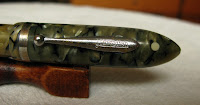The controversy is always there: Is that pen original or a copy of another? Which company did father that idea?
I have already spoken in these chronicles about some cases of plagiarism, or coincidence, or inspiration…—the
torpedo type of pens á la Montblanc Meisterstück, the
capless idea behind the Pilot model, the
black pocket pens made by the big three Japanese companies… And there are many other examples. After all,
nihil noui sub sole.
Today’s matching couple are two telescopic pens with very different birthplaces. Telescopic pens can be made longer from their compact dimensions in order to become normal in size when expanded. A more detailed analysis of a telescopic pen, a Pilot Short pen with golden nib, can be seen on the Chronicle entitled
"Origami".
 Capped and contracted.
Capped and contracted.The older is a
Pilot Short Pen originally released in 1968. It came with golden or steel nibs. It uses Pilot cartridges and the CON-20 converter.
 Capped and expanded.
Capped and expanded.
The second pen is a Parker Esprit, initially sold as Rotring Esprit during the 1990s. The end of the century sees how Sanford (Newell Rubbermaid’s stationery division) buys Rotring in 1998 and Parker in 2000. Some years later, the Rotring pen is modified to be marketed as a Parker model. As a result, the Esprit now uses short Parker proprietary cartridges instead of the short international ones used by the Rotring predecessor.
 Uncapped and expanded.
Uncapped and expanded.
As is often the case, the Pilot pen is rarely seen outside Japan, whereas the Rotring and Parker pens enjoyed a much wider distribution.
 The nibs are very different--semi-hooded on the Pilot, uncovered on the Parker. Pilot Pen also came with a 14 K gold nib, although not in the pen displayed on the picture.
The nibs are very different--semi-hooded on the Pilot, uncovered on the Parker. Pilot Pen also came with a 14 K gold nib, although not in the pen displayed on the picture. Copy, homage, inspiration or mere coincidence?
My thanks to Kinno-san.

(Parker Esprit – Parker Black)
Bruno Taut
(Madrid, November 18th, 2010)
[labels: Rotring, Parker, Pilot]

















































